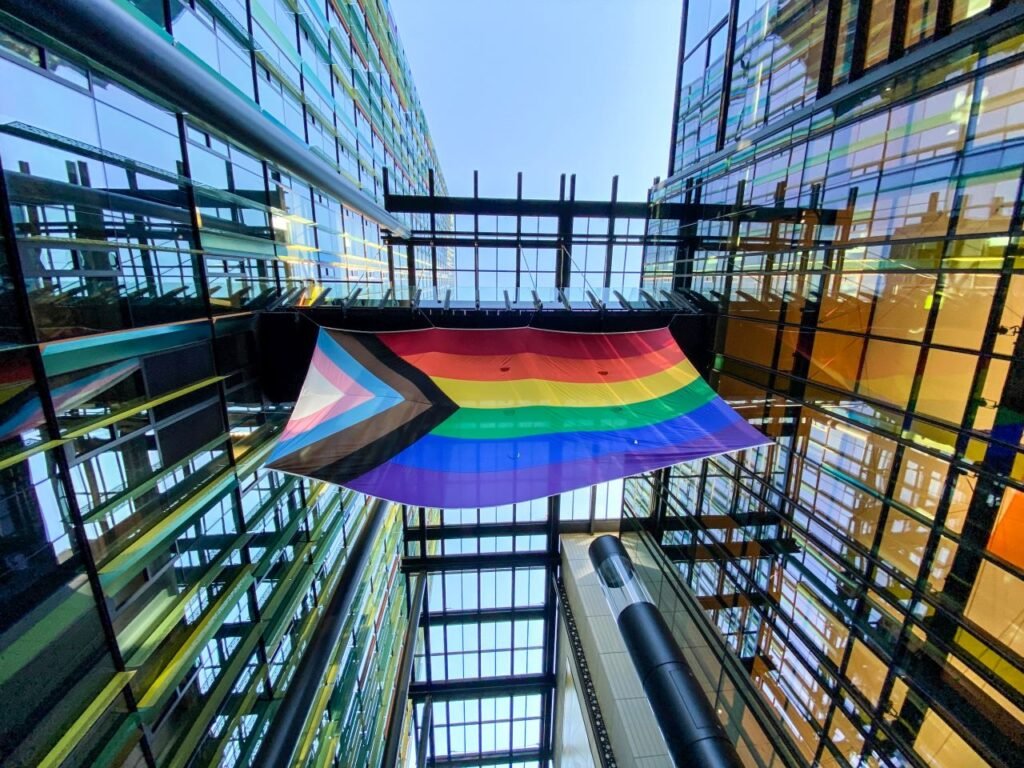We spend a significant portion of our lives at work, so it is important that we feel comfortable in our workspace. Even if our office is just a desk in a large room, we should feel supported by our employers. This is particularly important for LGBTQ+ individuals who often have to pretend to be someone they are not, in fear of not being accepted. Therefore the actions of employers have a significant impact on their well-being.
Everyday stress
According to a study by Deloitte on “Mental health and well-being in the workplace,” 47% of respondents stated that their main source of stress is work related. Another report (Deloitte 2023 Gen Z and Millennial Survey) indicates that 46% of Generation Z and 39% of millennials are stressed all or most of the time. Among the LGBTQ+ community, these figures are 56% (Generation Z) and 49% (millennials).
Imagine being stressed not only by the workload and approaching deadlines but also worry about attending a company event with a partner wondering whether it would be acepted. Individuals who are apart of the LGBTQ+ community often contemplate if it is better not to go at all, or to come alone and make up an excuse for their partners absnce, or to ask a friend to pretend to be their “normal” partner. Imagine that you would like to take a vacation, but you’re not sure if applying for funding would require disclosing personal information about your relationships. You don’t know if that will be necessary, but you’re afraid that even asking the question will raise suspicion and lead to a coming out, so you avoid it… Examples like these show how important real actions, open-mindedness, forward-thinking, and prevention of situations that can negatively affect employees are more than needed. Employers must remember that not everyone openly discloses their origin, age, religion, or sexual and gender identity. Therefore it is important to care for all employees with mind of their diveristy.
The publication “Safe Harbor: Why talk about LGBTQ+ individuals in the workplace?” highlights that employees in companies that do not provide a safe environment for LGBTQ+ individuals face many problems. These include difficulties in fully concentrating on work tasks, fatigue from constantly hiding their sexual orientation and gender identity from colleagues, avoiding team-building events, exhaustion, and depression.
DEI in practice
The need to report on Environmental, Social, and Governance (ESG) factors and keeping up with market changes means that employers cannot overlook non-financial factors in their actions. A significant part of ESG, particularly the social aspect, is Diversity, Equality, and Inclusion (DEI), which, in short, make employees feel like an essential part of the organization. To create a diverse, equal, and inclusive work environment, we cannot single out only certain groups; we must care for all employees. This includes programs to engage representatives of different age groups, support for working parents, accommodations for neurodivergent individuals, and actions to support the LGBTQ+ community.
Equal treatment in employment is dedicated to Chapter IIA of the Labor Code. In §1 art. 183a, it is stated: “Employees should be treated equally in terms of establishing and terminating employment relationships, employment conditions, promotion, and access to training for professional development, particularly regardless of gender, age, disability, race, religion, nationality, political beliefs, union affiliation, ethnic origin, religion, sexual orientation, employment on a fixed-term or indefinite basis, full-time or part-time employment.” Although this is a clear provision, many employers seem to overlook it. Discriminated employees do not bring their cases to court, even though they usually win such cases, as they often involve a public coming out which not everyone is comfortable with.
The Deloitte report titled “LGBTQ+ Inclusion @ Work: A Global Outlook” highlights that behaviors that exclude individuals identifying as women are more frequently mentioned. However, 40% of these individuals fear that their complaints will not be taken seriously, and one-third believe that the situation is not serious enough to report. In the case of respondents identifying as men, the respective percentages were 22% and 16%. This group, however, expressed greater concern than the first group that the situation could worsen (38% compared to 17%).
It is crucial for employers to actively support the LGBTQ+ community, moving beyond mere “just-in-case” policy provisions to provide tangible and ongoing support.
How to Support LGBTQ+ Individuals in the Workplace?
First and foremost, creating a safe work environment where everyone feels secure and accepted is essential. Our actions should involve supporting diversity, combating microaggressions and discrimination, organizing training and workshops for employees at all levels, and ensuring that everyone can present their ideas and opinions—creating a sense of empowerment and influence within the organization. Most importantly, we must ensure that representatives from diverse groups are included in teams and feel like integral parts of it.
Actions related to supporting LGBTQ+ individuals will vary depending on the size of the organization and available resources. However, the cornerstone is clear communication: “You can be yourself here.” It is important to remember that fear, often linked to homophobia, discrimination, and aggression, stems from ignorance. Therefore, organizing training sessions to educate employees about “all things LGBTQ+” is essential. Other actions include:
- A zero-tolerance policy for any form of discrimination.
- Open discussions by management about fostering an inclusive culture.
- Clear communication about the equality of benefits, such as vacation subsidies being available to all, not just those in marital relationships, but also to same-sex partners (both heterosexual and homosexual).
- Visible support for LGBT+ individuals, sharing information about these efforts not only internally but also externally (e.g., in communications with business partners or on a dedicated webpage).
- Support and encouragement for the formation of Employee Resource Groups (ERGs) created by employees within the organization, bringing together individuals who share common experiences or identities (beyond just the workplace).
- Active participation in the LGBT+ community, involvement in parades, and organizing events that help bring society together.
Benefits for All:
Taking care of the needs of all employees and genuinely including them in the organization provides benefits not only for the staff but also for the company as a whole. When employees feel supported, valued, and have a voice in the company, they become more engaged, efficient, and consistently focused on personal and professional development. The well-being of team members translates into the functioning of individual units within the organization and has a positive impact on the entire company. This leads to improved financial results, better understanding of diverse customers’ needs, increased innovation, enhanced company image, higher motivation and job satisfaction among employees, talent attraction and retention, and numerous other positive aspects.
As the Deloitte report “LGBTQ+ Inclusion @ Work: A Global Outlook” illustrates, employees who have not experienced exclusion are nearly twice as likely to stay in their current positions for more than five years, according to one-third of the respondents, while only 16% held the opposite view.
And it all starts with something that should be self-evident – the recognition that although we may differ from one another, we all deserve respect and a safe space to be ourtrue selves.





